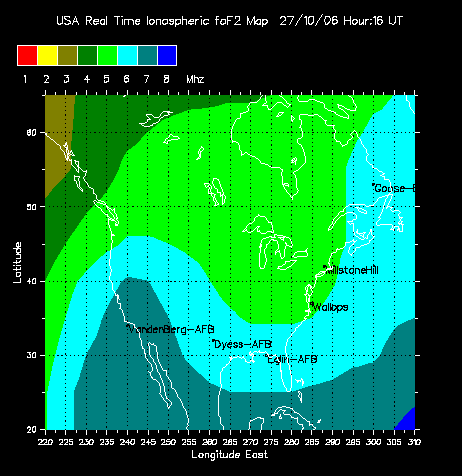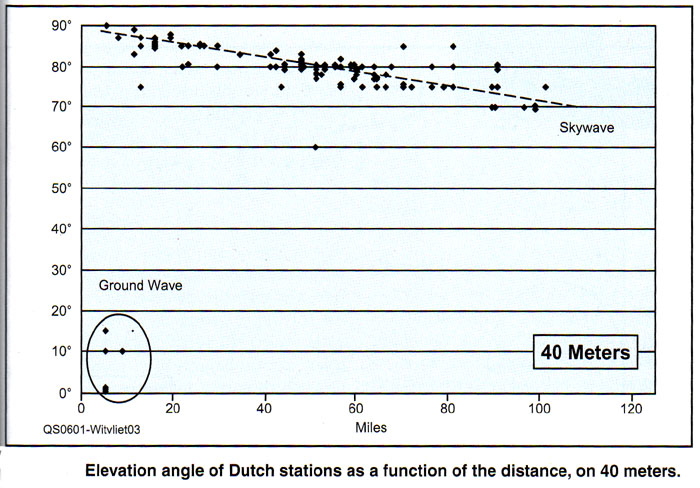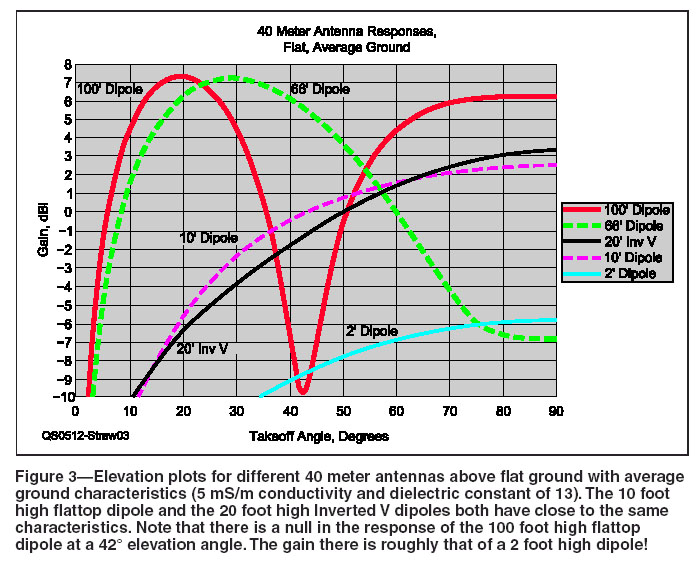(Near Vertical Incident Skywave)
WA9OTP, Dec, 2005
The NVIS antenna
is part of a system, for HF communications for 0-200 miles using
skywaves bounced off the reflective layers directly overhead.
This system must be employed by both sending and receiving
stations. This technique overcomes the line of sight restrictions
of VHF/UHF communication. Particular application is in
mountainous areas.
NVIS work is done with horizontally polarized antennas. The theory is that as a dipole is lowered closer to the ground plane, the radiation angle increases more toward vertical. The goal is to achieve nearly vertical incident radiation, so that it is reflected almost directly back down. The signal will penetrate the D-layer, with some loss, at about 30-60 miles, then be reflected at the F-layer at about 250 miles overhead.
Characteristics of this system:
[ ] There is a maximum usable frequency, MUF, for reflections from the F-layer. This MUF can be in the range of up to 12 MHz or less during daytime, and 5 MHz or less at night. So...., 40M or 30M daytime (maybe), 80M at night. Real time information about the MUF for your area is available at http://www.ips.gov.au/HF_Systems/4/3
A recent mid-day display of MUF for North America is shown below. Notice MUF max is 5 MHz.

[ ] The listening area of the antenna is less than that of a DX antenna. The antenna is only receiving from a foot print of maybe 200 mile radius, rather than 'world wide' for a DX antenna. Hence, the background noise level is reduced.
Resources:
[ ] QST, Jan, 2006, page 28, Elevation Angle Measurements During a Local Contest by a group from Holland. One of their interesting charts is below:

NVIS work is done with horizontally polarized antennas. The theory is that as a dipole is lowered closer to the ground plane, the radiation angle increases more toward vertical. The goal is to achieve nearly vertical incident radiation, so that it is reflected almost directly back down. The signal will penetrate the D-layer, with some loss, at about 30-60 miles, then be reflected at the F-layer at about 250 miles overhead.
Characteristics of this system:
[ ] There is a maximum usable frequency, MUF, for reflections from the F-layer. This MUF can be in the range of up to 12 MHz or less during daytime, and 5 MHz or less at night. So...., 40M or 30M daytime (maybe), 80M at night. Real time information about the MUF for your area is available at http://www.ips.gov.au/HF_Systems/4/3
A recent mid-day display of MUF for North America is shown below. Notice MUF max is 5 MHz.

[ ] The listening area of the antenna is less than that of a DX antenna. The antenna is only receiving from a foot print of maybe 200 mile radius, rather than 'world wide' for a DX antenna. Hence, the background noise level is reduced.
Resources:
[ ] QST, Jan, 2006, page 28, Elevation Angle Measurements During a Local Contest by a group from Holland. One of their interesting charts is below:

[ ] QST, Dec, 2005, page 39, What's the
Deal about NVIS? by Straw (10 MByte .pdf)
A chart showing 40M NVIS antenna characteristics -- gain vs take off angle for different heights.
Interesting that a good DX dipole at 100' works well for NVIS, although it also would be collecting noise and signals incoming at 0 - 45 degrees, too.
The 40M DX dipole at 66' is very poor for NVIS.
This chart suggests a dipole (flat top or inv V) at 10-20' is good.

A chart showing 40M NVIS antenna characteristics -- gain vs take off angle for different heights.
Interesting that a good DX dipole at 100' works well for NVIS, although it also would be collecting noise and signals incoming at 0 - 45 degrees, too.
The 40M DX dipole at 66' is very poor for NVIS.
This chart suggests a dipole (flat top or inv V) at 10-20' is good.

[ ]
KV5R: Understanding NVIS
Antenna and Propagation
Experimentation by Harold Melton.
Harold has an excellent section on exactly how to build an NVIS antenna system, including feed point impedances and use of non-resonant antennas.
He also includes many other links on NVIS antennas.
[ ] http://www.qsl.net/wb5ude/nvis/
Harold has an excellent section on exactly how to build an NVIS antenna system, including feed point impedances and use of non-resonant antennas.
He also includes many other links on NVIS antennas.
[ ] http://www.qsl.net/wb5ude/nvis/